Duolingo Review: It’s History, Founder and Pros & Cons
You can learn new languages with the help of the entertaining and cost-free program Duolingo. It’s similar to playing a game where you advance through stages and gain points while improving your language abilities. You can explore unusual languages or pick up common ones like Spanish, French, and more. The software employs techniques to improve word and phrase retention. Duolingo may be used on a computer or phone, making it simple to learn wherever you are. It’s a fantastic way to meet new individuals from different cultures and learn new languages. In this full blog, we will help you to know about Duolingo by giving Duolingo review, history, and Pros & cons.
What is Duolingo?
An engaging and dynamic way to learn new languages, Duolingo is a well-known and cutting-edge language-learning program. The goal of Duolingo, which was founded by Luis von Ahn and Severin Hacker, is to make education available to all people. From more widely taught languages like Spanish and French to less well-known ones like Swahili and Esperanto, it offers a variety of language courses.
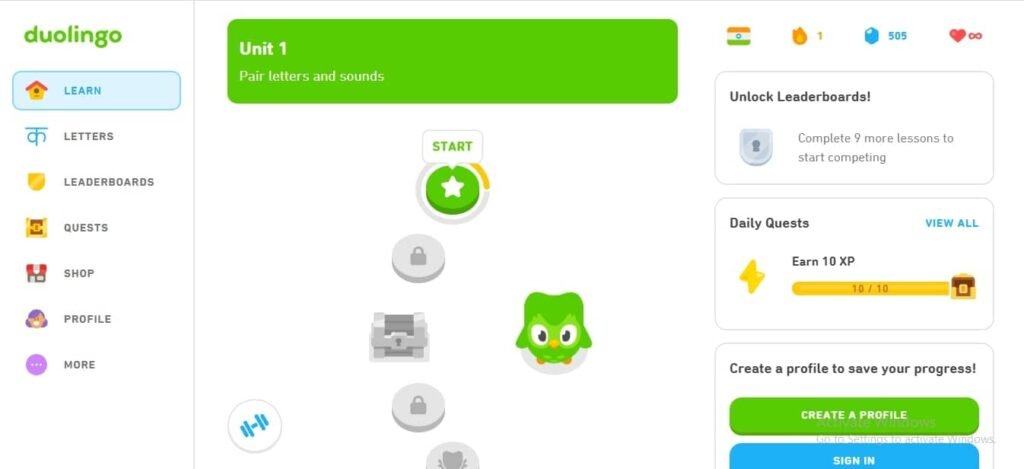
With its gamified methodology, Duolingo engages students with brief, digestible courses that develop their reading, writing, speaking, and listening abilities. Users accumulate points, levels, and streaks, which transforms studying into a fun journey. Duolingo stands out thanks to its unique mix of instruction and crowdsourced translation.
As users advance, they assist in translating content from the real world, assisting in the removal of language barriers on the internet. Duolingo’s adaptive learning adjusts to your pace whether you’re a novice or trying to enhance your language abilities, providing an efficient and individualized learning experience. Duolingo’s user-friendly interface and accessibility empower millions of people to start a language-learning adventure and discover new cultures.
History of Duolingo
The way that we learn and master languages has changed due to Duolingo’s emergence as a transformational force in the field of language education. When Luis von Ahn and Severin Hacker introduced Duolingo in 2012, it was clear that their goal was to democratize education through the use of a free, gamified platform. It brought together language instruction with crowdsourced translation, enabling users to study while assisting with actual tasks.
As mobile apps were released, Duolingo’s mission gained pace and learning became available anywhere and whenever. Its creative strategy made learning a language an exciting journey by gamifying achievements, leveling up, and streaks. The platform’s capabilities went beyond the individual learner, entering classrooms with “Duolingo for Schools.” They were used effectively by educators to develop language proficiency in a variety of contexts.
The number of courses offered by Duolingo expanded over time, covering a wide range of languages and serving a worldwide clientele. Through the use of an adaptive learning system, efficacy was increased. With the launch of Duolingo Plus, premium users now have access to an offline, ad-free experience.
With “Duolingo ABC,” Duolingo will grow even more in 2024, encouraging young readers. Its inventive past serves as an example of a dedication to removing obstacles, facilitating access to education, and integrating cultures via the use of language. The development of Duolingo is evidence of how technology can spark a global language revolution and promote communication and understanding.
Who are the Founders of Duolingo?
Severin Hacker and Luis Von Ahn invented the Duolingo app. The work of computer scientist and entrepreneur Luis von Ahn on CAPTCHA and reCAPTCHA as well as his contributions to the study of human computation are well known. Swiss computer scientist Severin Hacker was also involved in the company’s founding. They joined forces to create Duolingo in 2012 to offer free language instruction and utilize users’ efforts to contribute to the translation of materials on the Internet.


How does Duolingo Work?
Have you ever wondered how Duolingo so readily makes learning a language an adventure? Let’s reveal the brilliance behind this cutting-edge platform.
Duolingo is based on the straightforward yet brilliant idea that learning a language should be fun, easy to do, and efficient. Setting daily learning objectives and choosing the language you want to learn are the first steps in the process. After that, the site guides you through interactive courses on speaking, listening, writing, and reading.
Each lesson is created as a manageable challenge that you can easily include in your daily activities. Duolingo uses a gamified methodology, rewarding users for regular practice with points, virtual money, and streaks. These incentives foster achievement as well as motivation in students.
The adaptive learning mechanism is at the core of Duolingo’s power. Lessons are customized based on your development, capabilities, and weaknesses. The method gives you additional practice until you have grasped a subject if you are having trouble with it.
The use of crowd-sourced translation is one of Duolingo’s unique features. By translating materials from the actual world as you study them, you make learning a language a worthwhile undertaking that affects international communication.
Speech recognition technology is used in the listening and speaking workouts to enhance pronunciation and comprehension. Additionally, the community features and discussion boards promote a sense of camaraderie among students, enabling them to ask for assistance and exchange stories.
In essence, Duolingo functions by skillfully fusing learning and enjoyment. It redefines language learning by its user-centered design, adaptability, and incorporation of real-world applications. As you begin your Duolingo journey, keep in mind that each lesson advances the global language revolution while also bringing you one step closer to proficiency.
Here are the steps for using the Duolingo application:
Step 1.
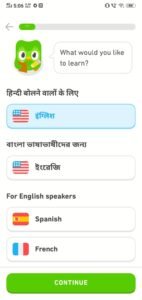
Step 2.
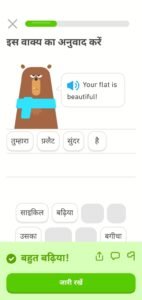
Step 3.

Step 4.
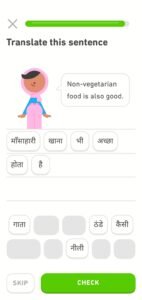
The Target Audience of Duolingo
Duolingo, the language-learning juggernaut, has carved its niche by appealing to various language enthusiasts. From students seeking academic excellence to globe-trotters aiming to enhance their travel experiences, Duolingo casts a wide net.
- Students: Duolingo’s user-friendly interface and gamified approach attract students of all ages. Whether acing language exams or adding an edge to college applications, students find Duolingo an invaluable tool.
- Travel Enthusiasts: Wanderlusters embarking on global escapades use Duolingo to confidently navigate foreign lands. Learning key phrases and cultural nuances enhances their travel interactions.
- Professionals: Multilingualism boosts career prospects, and Duolingo caters to professionals seeking to broaden their horizons. Learning a language can lead to better job opportunities and international collaborations.
- Language Enthusiasts: For those passionate about linguistics, Duolingo offers an avenue to explore languages outside their comfort zone, deepening their understanding of different cultures.
- Busy Individuals: Duolingo’s bite-sized lessons fit seamlessly into hectic schedules, making it an attractive option for busy parents, working professionals, or anyone seeking convenient self-improvement.
- Hobbyists: Language learning, for some, is a hobby. Duolingo’s engaging format turns to learn into a pleasurable pastime.
- Seniors: Duolingo’s inclusive design accommodates older learners keen on cognitive stimulation and staying mentally agile.
What Languages can you Learn with Duolingo?
Duolingo, the acclaimed language learning platform, invites language enthusiasts on an international adventure with its wealthy and numerous array of publications. From the widely spoken to the lesser-known, Duolingo gives an impressive variety of languages, fostering move-cultural connections and opening doorways to new horizons. For English speakers, Duolingo offers publications in an intensive choice of 37 real-international languages.
These consist of Arabic, Chinese, Czech, Danish, Dutch, Esperanto, Finnish, French, German, Greek, Haitian, Creole, Hawaiian, Hebrew, Hindi, Hungarian, Indonesian, Irish, Italian, Japanese, Korean, Latin, Navajo, Norwegian, Polish, Portuguese, Brazilian, Romanian, Russian, Scottish, Gaelic, Spanish, Swahili, Swedish, Turkish, Ukrainian, Vietnamese, Welsh, Yiddish and Zulu Beyond these 37 languages, Duolingo’s also working on many more languages too.
It accommodates numerous studying paths by incorporating exclusive languages as training mediums. For instance, Catalan for Spanish speakers or French for Arabic speakers, broadening the linguistic horizons even further.
Furthermore, Duolingo’s commitment to selling English proficiency extends via its ESL (English as a Second Language) programs. These cater to speakers of many languages, encompassing Arabic, German, Hindi, Spanish, and more. While Duolingo’s catalog is large and various, it recognizes that the world of languages is boundless.
For the ones in search of languages beyond its repertoire, opportunity systems like Pimsleur, Transparent Languages, Mango Languages, or even specialized alternatives like American Sign Language (SignIt ASL) can provide further avenues of exploration.
In a digitally linked global in which languages unite cultures and foster know-how, Duolingo stands as a catalyst for the language-getting-to-know adventure. Whether you’re studying the complexities of Chinese characters or delving into the nuances of Russian grammar, Duolingo is your international partner, guiding you in the direction of a universe of linguistic mastery and significant connections.
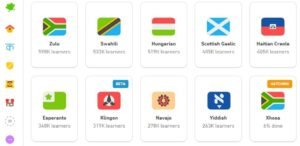

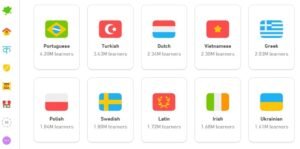
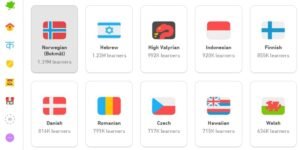
What is Duolingo Incubator?
At the heart of Duolingo’s mission lies the Incubator – a collaborative space where language enthusiasts and experts unite to create courses for learners worldwide. This unique initiative not only expands Duolingo’s language offerings but also celebrates the beauty of cultural exchange. It’s a testament to the platform’s commitment to making language accessible to all, regardless of how commonly spoken or regionally specific the language may be.

Diverse Activities for Engaging Learning
Duolingo goes beyond traditional learning methods, offering a variety of activities to keep learners motivated and engaged:
- Refill Your Health: This gaming-inspired feature encourages consistent practice by replenishing “health” with daily lessons. Replenishing health by completing daily lessons adds an element of challenge and encourages consistent practice. It’s a unique way to gamify learning and keep learners coming back for more.
- Streak Freeze: Keep your streak alive by completing lessons every day, motivating you to stay on track. A language-learning streak is a powerful motivator. Duolingo’s “Streak Freeze” activity challenges you to maintain a consecutive day streak by completing lessons daily. As the number of days increases, so does your motivation. This feature instills discipline and turns learning into a rewarding habit.
- Additional Benefits: Unlock specialized lessons beyond the basics, delving into culture, idioms, and more. The interactive nature of diverse activities heightens user engagement, fostering a deeper connection to the language and its nuances.
- Double or Nothing: Bet your streak on practicing daily – double or lose it all!
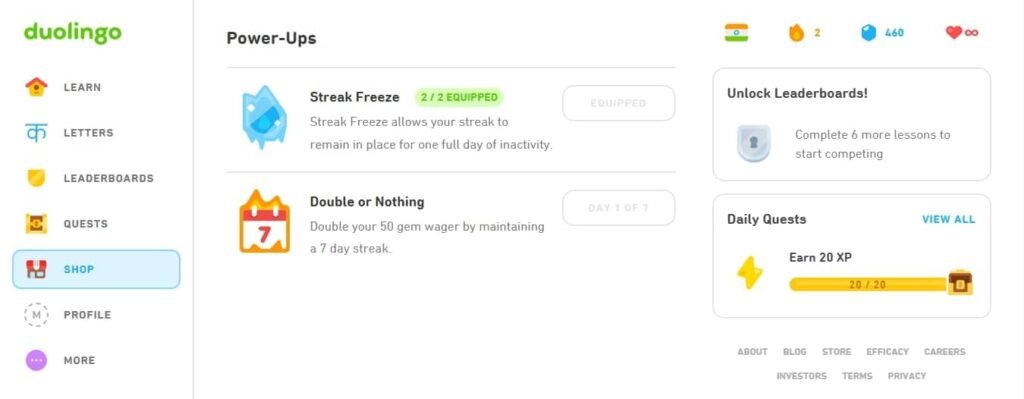
Unveiling Pros & Cons of the Duolingo Application
Pros
- Learn Anytime, Anywhere – Duolingo is like having a language teacher in your pocket. You can use it on your phone or tablet. This means you can learn whenever you have a little free time – like when you’re waiting for the bus or during lunch breaks.
- Learning Becomes a Game – Learning can be fun, just like playing games. Duolingo makes learning languages feel like a game. You earn points and move up levels as you learn. You can also challenge your friends. It makes learning feel exciting!
- An Array of Languages at Your Fingertips – Duolingo has many different languages you can learn. You can choose languages you’re interested in, even ones you might not have heard of before.
- Cost-Free Learning for All – Guess what? Duolingo is free! You don’t have to pay to use most of its features. This means anyone can use it to learn, no matter how much money they have.
- Learning Made Just for You – Duolingo knows everyone learns differently. It’s like having a teacher who knows exactly what you need. It makes lessons that fit you, so you learn better and memorize more.




Cons
- Might Not Be Enough for Experts – If you’re already good at a language, Duolingo might not be enough to help you get even better. It’s great for beginners, but it might not cover all the advanced stuff you want to learn.
- It Feels Like a Game – Duolingo is fun because it’s like playing a game. But sometimes, you might focus more on winning the game than really learning the language. It’s important to balance fun with serious learning.
- Learning to Talk in Real Life Duolingo is good for reading and writing, but it might not help you talk to people in real life. Language is about speaking too, and Duolingo might not prepare you for that as well as other methods.
- Fluency Takes More Than Duolingo Duolingo is a good start, but you’ll need more practice to speak a language well. Fluency means understanding jokes, using slang, and sounding like a native speaker – things Duolingo can’t fully teach.
- Might Be Better for English Speakers If you don’t speak English, Duolingo might not be as helpful. Some parts of the app focus a lot on English, which could be tricky if it’s not your first language.
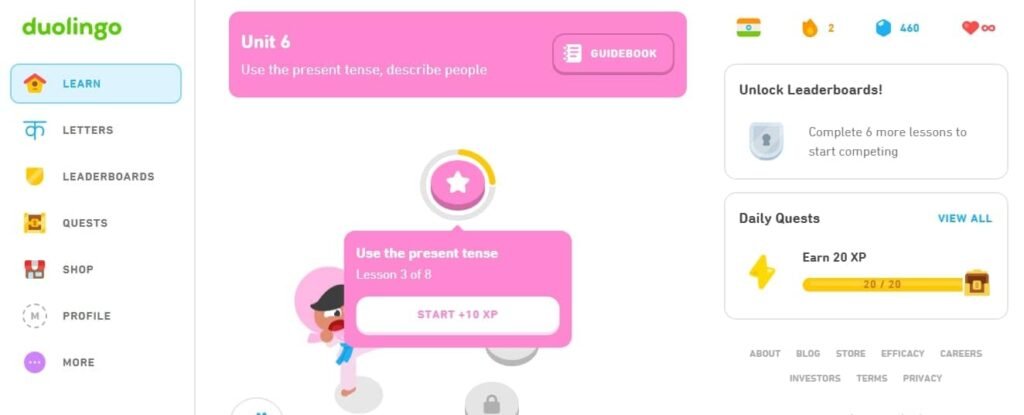
Free vs. Paid Duolingo Application
Learning a new language can be an exciting journey, and Duolingo is a popular companion for many language enthusiasts. But here’s the question: should you stick with the free version or go for the paid Duolingo Plus? Let’s break down the differences and help you decide.
Free Version of Duolingo: The Basics
The free version of Duolingo offers a lot of great features. You can choose from a variety of languages and start learning right away. The engaging and interactive lessons make learning a new language seem like fun. Additionally, it won’t cost you anything, which makes it ideal for students on a limited budget.
What is Duolingo Plus?
The application’s commercial version is called Duolingo Plus. You can get more benefits for a monthly cost. You can download lessons to learn offline and there are no commercials, which makes learning easier. Additionally, you are given a streak repair in case you skip a practice day. Duolingo Plus can be a good option to take into consideration if you’re a committed learner looking to step up your language acquisition.
Making the Decision: Paid or Free?
Your preferences and goals will determine whether you use Duolingo for free or for a fee. The free edition is great for those just getting started. It enables you to discover several tongues and acquire a feel for the app. But Duolingo Plus can be a wise investment if you’re devoted to learning a language and want to get started without delays.
In the end, each choice has advantages. The road to language mastery is in your hands, whether you decide to use Duolingo for free for casual learning or pay for Duolingo Plus for a more concentrated experience.
Why is Duolingo So Popular?
- Gamified Learning Approach: Duolingo uses a gamified method of language instruction to make learning a fun and interesting experience. Users are encouraged to keep learning by giving them a sense of accomplishment and progress through the use of points, awards, levels, and interactive lessons.
- User-Friendly Interface: The platform is accessible to students of all ages and educational backgrounds because of its simple and user-friendly interface. Users are guided through the learning process by the user-friendly design and concise instructions, which lower any potential entrance barriers.
- Accessibility for Free: Duolingo provides a no-cost version that enables people to take introductory language courses. Due to this accessibility, learning languages has been more widely available to all people, attracting a large worldwide user base that includes students, professionals, and casual learners.
- Numerous Languages: Duolingo offers courses in a huge variety of languages, from well-known ones like Spanish and French to lesser-known ones. A large audience with a variety of linguistic interests and goals is served by this broad range of languages.
- Mobile-Friendly Platform: With Duolingo’s mobile app, users can study while on the go, incorporating language learning into their busy lives. Its attractiveness is increased by its versatility, which works well with modern lifestyles.
- Structured Curriculum: Duolingo offers lessons one at a time so that users can learn the language logically and completely. This arrangement gives students a sense of direction and purpose, which enhances the learning process.
- Community and Social Features: Features that foster community and social interaction include leaderboards and the ability for users to compete against friends. This social element adds a sense of competition and responsibility, which motivates users to keep using the service.
- Regular Updates and Improvements: Duolingo continuously updates and enhances its courses based on user feedback and evolving philosophy for language acquisition. Users remain engaged with and trust in the platform as a result of this commitment to process improvement.
- Effective Language Education Methods: Duolingo employs several effective language education methods, such as exercises in speaking, listening, reading, and writing. Thanks to this all-encompassing approach, users build self-assurance and acquire well-rounded language skills.
- Research-based Approach: Duolingo’s approach is based on research in cognitive science and language acquisition. Because of the platform’s theoretical underpinnings in teaching, it is more effective.
My Personal Duolingo Review
Hey there! I simply wanted to express my opinions about Duolingo. Sincerely, utilizing it to learn different languages has been a blast. It’s similar to a fun game that systematically teaches you a language. I’m not an expert, but even I found it easy to use. They offer many languages, so you can pick the one you like. As you learn, you earn points and move up levels.
It’s super satisfying! Some parts are really good and make learning cool, but a few could be better. Remember, it’s a good start, but trying other ways of learning can be helpful. In a nutshell, Duolingo rocks for beginners like me. It’s fun, it’s simple, and you might even surprise yourself with how much you learn!
In my assessment, Duolingo’s review deserves a 4 out of 5 rating. While it excels in making language learning fun and accessible, it falls short in catering to advanced learners and comprehensive language mastery.
Related Topics:
| Sr. No. | Topic Name |
|---|---|
1. | |
2. | |
3. | |
4. | |
5. | |
6. | |
7. | |
8. | Hello Talk Review |
9. | Lingbe Review |
10. | Babbel Review |